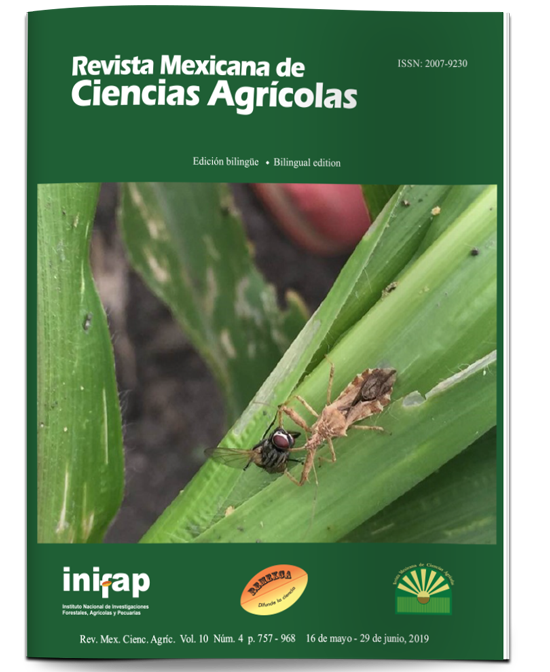Interaction of environmental factors and natural enemies with populations of Aulacaspis tubercularis Newstead in Nayarit, Mexico
DOI:
https://doi.org/10.29312/remexca.v10i4.1708Keywords:
Aulacaspis tubercularis, Ataulfo cultivar, white mango scaleAbstract
The objective of this study was to know the population dynamics of the white mango scale, Aulacaspis tubercularis Newstead at different temperatures and determine the relationships between climate factors and natural enemies with the populations of the scale. The study was conducted in 2013-2014 on seven mango thefts (Manguifera indica L.) of the Ataulfo cultivar, located in places with different temperatures in San Blas, Nayarit. In each orchard, populations of white scales and their insect predators were recorded every two weeks. Variance analyzes were carried out to compare the populations between sampling dates and localities; correlations were also obtained between temperature, rainfall and the complex of predators with the populations of the pest. The highest population levels of the white scale of mango were recorded during the period with higher temperatures and without rainfall (April-June); in contrast, during the period with rainfall, the population in all orchards was scarce or nonexistent. A positive correlation of the temperature was determined with the population of the white scale of the mango, in such a way that the increase of the temperature during the year favored the increase of the populations of the pest. In contrast, rainfall negatively impacted the pest by drastically reducing the density of its populations. Finally, the increase of the populations of the scale favored the increase of the population density of the complex of predators of the plague.
Downloads
Downloads
Published
How to Cite
Issue
Section
License
The authors who publish in Revista Mexicana de Ciencias Agrícolas accept the following conditions:
In accordance with copyright laws, Revista Mexicana de Ciencias Agrícolas recognizes and respects the authors’ moral right and ownership of property rights which will be transferred to the journal for dissemination in open access. Invariably, all the authors have to sign a letter of transfer of property rights and of originality of the article to Instituto Nacional de Investigaciones Forestales, Agrícolas y Pecuarias (INIFAP) [National Institute of Forestry, Agricultural and Livestock Research]. The author(s) must pay a fee for the reception of articles before proceeding to editorial review.
All the texts published by Revista Mexicana de Ciencias Agrícolas —with no exception— are distributed under a Creative Commons License Attribution-NonCommercial 4.0 International (CC BY-NC 4.0), which allows third parties to use the publication as long as the work’s authorship and its first publication in this journal are mentioned.
The author(s) can enter into independent and additional contractual agreements for the nonexclusive distribution of the version of the article published in Revista Mexicana de Ciencias Agrícolas (for example include it into an institutional repository or publish it in a book) as long as it is clearly and explicitly indicated that the work was published for the first time in Revista Mexicana de Ciencias Agrícolas.
For all the above, the authors shall send the Letter-transfer of Property Rights for the first publication duly filled in and signed by the author(s). This form must be sent as a PDF file to: revista_atm@yahoo.com.mx; cienciasagricola@inifap.gob.mx; remexca2017@gmail.
This work is licensed under a Creative Commons Attribution-Noncommercial 4.0 International license.



